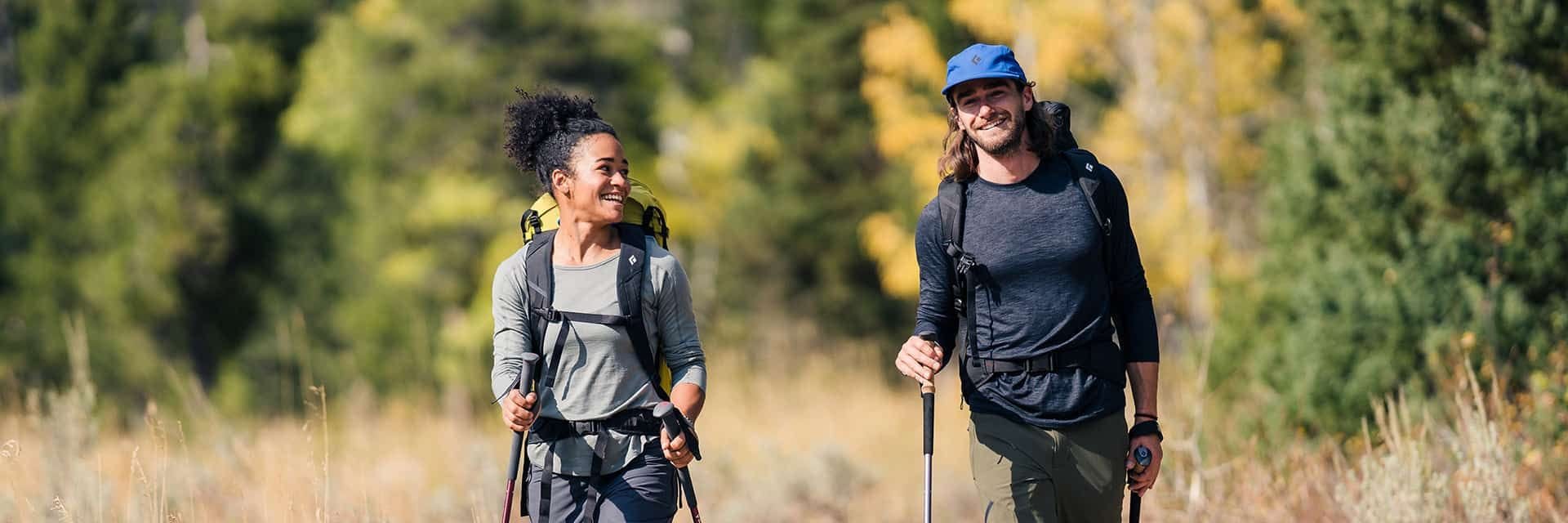In both outdoor activities, what you bring with you can simplify the process and make the adventure a lot more enjoyable. Examples of essential equipment include footwear, clothing, backpacks, and accessories like walking poles.
In this article, we’re going to dive into the similarities and differences between hiking and trekking. We’ll also pour over the critical gear you need to make your next trek or hike more enjoyable.
Similarities between Trekking and Hiking
For starters, both concepts require you to use your feet! The idea of human-powered movement is central; you’re walking either way. You also need gear to sustain both activities, which is where Altitude-Sports comes in.
Men’s footwear and women’s footwear are important components of hiking and trekking. You want hiking boots or shoes that support your unique foot shape and are durable enough to handle a long walk.
Other similarities include the items you bring with you. Examples include nutrition and water via a water bottle or hydration pack. A backpack is also a critical tool to carry essential things like a phone, wallet, keys, and any navigation tools you might want to bring.
Health impact
Another realm of similarities involves your overall health. With proper gear and preparedness, hiking and trekking can boost your mental and physical health.
Hiking and trekking lower the risk of ailments like heart disease and can even improve your blood pressure and cardiovascular health. Since they’re both labour-intensive activities, your physical health improves too. Hiking and trekking can help strengthen your lower leg muscles and improve your overall fitness level.
Trekking and hiking also positively impact your mental health. The activities are fantastic ways to reduce stressful thinking, redirect your mind to the task at hand, and enjoy the great natural beauty that exists all around us. Both activities allow us to remove ourselves from a typical routine, which increases self-reflection and gives us a new perspective on personal issues.
Time spent in the great outdoors is time well spent.
Differences in Terrain for Trekking and Hiking
Despite numerous similarities, there are some notable differences between hiking and trekking.
Trekking alludes to a long journey that may be arduous or take several days. It could take place in any number of environments and involves travelling long distances over difficult terrain. However, a trek does not need to be in the woods or confined to hiking trails.
For example, if you’re snowed in and need to walk 20 miles to get supplies, that would be a trek. World-famous pilgrimage-inspired routes like the Camino del Santiago, which oscillates between the countryside, roadsides, and cities, is a trek. Consecutive multi-day hikes could be considered treks as well.
Hiking can also be arduous, but it can just as easily be pleasant. Hikes usually occur on hiking trails, but a casual walk in the woods is as much a hike as getting to the top of a big mountain is. Hiking is also generally used to describe an activity that takes place in a natural environment, like the woods or mountains. Trekking can be applied more universally.
There are also linguistic differences depending on what part of the world you live in. In the U.S., hiking is used more exclusively. In Canada, Australia, and New Zealand, trekking is used frequently and often interchangeably with hiking.
Differences in Duration and Distance
Building on the previous section, a trek can be a multi-day hike that covers long distances far surpassing the distance of hikes. It doesn’t have to be an extreme distance, but it does have to be difficult. Long-distance recreational trails (Howe Sound Crest, Bruce, or Appalachian Trail) would fit into the trekking category.
You can take a hike on any of the trails mentioned before, but that usually indicates a smaller section of the longer trail. A hike can range from a full day’s effort to only a few hours. Of course, that doesn’t mean all hikes are easy, but they tend to be better for people with time restrictions.
On a scale from a walk (casual) to an odyssey (demanding and long term), a trek fits closer to the odyssey, while a hike is closer to a walk.
Differences in Physical Demands
How you prepare for each is also different. Hikes generally require proper footwear, nutrition, outdoor clothing, and a pack. Check out our hiking gear and apparel for the best options.
A trek tends to demand more than a hike. You need the gear for a hike, plus multiple days of supplies and extra carrying capacity. Tents, cookware, a sleeping bag, and walking poles are all used for treks. Weight considerations also become key; over the course of many days, every extra ounce you carry matters.
On a smaller hike, by contrast, critical weight matters less. If it’s an easy trail that only takes a few hours, you can bring things like books, child carriers, or a picnic set, which may otherwise seem excessive on a trek.
Differences in Climate and Weather
Trekking and hiking can occur rain or shine, and you should prepare for both. For trekking trips, weather conditions matter more. If you encounter bad weather three days into a 5-day trek, you’re just going to have to deal with it. This means securing weather-resistant clothing, rain covers, and health and safety equipment.
Hiking has a bit more choice to it. If you can match your activity to a good day, you can avoid a lot of the weather components. However, most of us don’t have open schedules, so prepare for what the weather gives you.
Seasonality has a lot to do with preparedness. In the summer, bug spray and bug nets are good to have, along with sun protection. In the shoulder seasons, with shorter days, lighting will be key. And, of course, in the winter, snow gear like snowshoes, microspikes, and winter clothing will be important.
The Gray Area
Despite the differences, hiking, and trekking are used interchangeably. A thru-hike, for example, is closer to trekking than hiking. Someone who is going to complete a long trail in one continuous adventure is said to be thru-hiking. Trekking is also been regularly outside of the outdoor realm to describe arduous journeys.
When a hike turns into a trek is also an interesting gray area. Longer overnight hikes may qualify, but it’s up to the participants to describe the adventure. In any case, it’s not wrong to call a hike a trek and vice versa.
Essential Gear and Equipment
There are a lot of gear choices out there for aspiring hikers and trekkers to sift through. In each case, you want to prioritize value over time. The outdoors are rough on gear. A lower-cost item that doesn’t last long will only force you to buy something else.
The most important element for both hiking and trekking is selecting the right hiking shoes. Your feet are your tickets to freedom, so treating them well is a smart first step. Focus on durability and quality. Top-line rain gear, cookware, sleeping bags, hiking boots, and outdoor clothes will take care of you for a long time.
Useful hiking and trekking equipment examples include hiking poles (also called walking poles), multi-use clothing, a light day backpack, a hydration pack, or an overnight pack for longer adventures. And while soaking up some Vitamin D, “the sunshine vitamin,” always feels nice, burning does not. For warmer seasons, bring bug spray, a hat, and sun protection. Extra layers and beanies are nice for colder-weather adventures.
Conclusion
Hiking and trekking are similar concepts but have a few key differences. Both involve walking, with hikes generally taking place on a hiking trail and in a natural environment. Trekking trips and trekking routes can be considered long, arduous journeys. A trek covers thru-hikes, multi-day hikes, and some longer overnight hikes. Treks also do not have to take place in a natural environment.
As far as preparedness goes, trekking equipment is usually more comprehensive. You need to think about multiple days moving through challenging environments. A hike can also be difficult and cover rugged terrain, but it’s much shorter.







